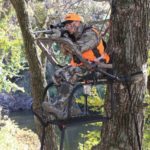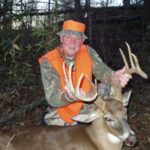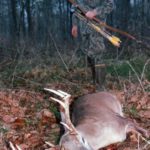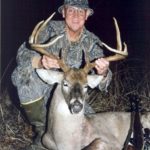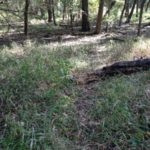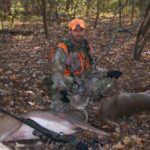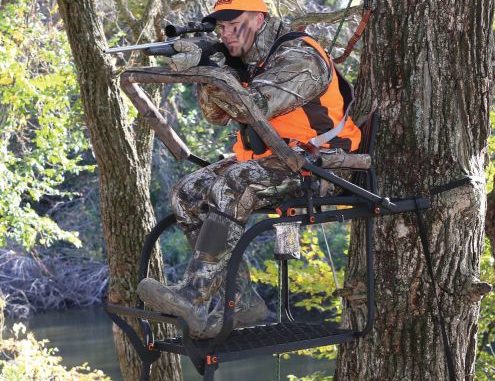
Stumped by late-season deer hunting? Stop overcomplicating your strategies — get back to the basics and kill more bucks.
Every time I get a chance to chat with Warren Womack, I learn something new about deer hunting.
There’s no surprise there, though, if you actually know who he is.
Womack, a resident of East Feliciana Parish, has turned deer hunting into a flawless art, chasing whitetails with skilled precision in Louisiana and Mississippi for longer than I’ve been alive — around 46 years.
The impressive part is that he’s killed a lot of deer — a lot. As of November, he had harvested 175 deer with a compound bow, 101 with a recurve and 97 with firearms to total 373 deer during his tenure as a hunter.
It’s safe to say that when Womack speaks I listen.
The 70-year-old is still consistent in harvesting deer, too, even though he “can’t cover as much ground as the younger days.”
From October through February, Womack is a force to be reckoned with in the woods, with bow or gun in hand.
“How do you do it?” I asked Womack on a phone call late last year. “What are you doing to find and potentially pattern bucks late in the season during the rut?”
My preconceived notions immediately drifted toward a response including finding buck sign or doe bedding areas or calling techniques.
But Womack chuckled a bit before answering.
“I hunt like I do all season,” he said. “I don’t do anything different.”
I was surprised by his response, but Womack continued to explain his approach.
“I never put all my marbles in the rut basket,” he said. “Just because bucks have does on the mind doesn’t mean they have lost their mind. They’ve been hunted so much that they become aware of stuff.
“They relocate to different areas with (less) pressure.”
Womack’s perspective on the rut is a telling one, to say the least, when today hunters are often under the impression that just a rattle here, doe bleat there and estrous wafting from every direction will easily lure in a wall hanger.
Sure, deer — particularly for a hunter’s interest, mature bucks — are on the move during the short breeding window that in Louisiana varies from November to February in certain areas of the state.
But the notion that bucks are running amuck around the woods in search of a suitor is, Womack said, a delusion.
Womack’s solution to finding late-season bucks is so practical he employs it at anytime of the year.
Early in the season, he looks for feed trees dropping acorns with heavy deer activity in the vicinity.
Fast forward to January, and his tactics haven’t veered much.
He’s particularly looking for late-dropping nuttall oak acorns (that can often produce until February) or heavily traveled corridors.
“Walk and look and find sign — a travel area, a distinct line from one place to another,” Womack said. “If there’s a dip in elevation, (deer) favor that; they use that for cover.
“I call them flow areas.”
The most-important tool in Womack’s arsenal, though, is aggressive scouting. He never stops scouting during the season, often covering multiple miles in a day searching for stellar deer sign.
Lyle Savant also has covered some serious ground looking for deer. He’s an Area 6 public-land diehard, frequenting Indian Bayou in the Atchafalaya Basin, Cat Island National Wildlife Refuge and, mostly, Sherburne Wildlife Management Area, visiting the latter frequently during the rut.
“It’s a misconception about the rut that (deer) run all over all day long,” Savant said. “It’s not true, from my experience on public land. They pattern us just like we try to think we can pattern them.”
Savant’s works at patterning deer by finding trodden trails and fresh droppings.
“Finding deer droppings that are fresh —that’s better sign than scrapes and rubs,” Savant said. “Of course, the icing on the cake is if I can find an acorn tree still dropping at that time of year.”
The areas in which Savant is usually successful lie somewhere with an appearance that isn’t pretty — meaning productive areas are far inside swampy sections of woods, where deer can traverse hidden ridges and thickets.
Savant doesn’t put his effort toward finding scrapes, rubs and other buck sign because he knows just as well as Womack that doe sign is as good as gold during the rut.
“I don’t care if there’s not a rub or scrape in the whole area,” Savant said. “A lot of people get hung up with the bucks: I think they miss a lot of good sign because they’re looking for buck sign.”
Yet, focusing on scrapes seems like an idea worth investing time into because, after all, bucks are the ones pawing into the ground and depositing scent on overhanging branches. Thus, scrape equals buck, right?
The answer isn’t so black and white, according to Dr. Karen Alexy Waldrop with the Kentucky Department of Fish and Wildlife Resources.
Actually, hunting strictly near scrapes during the rut is “probably a poor decision,” she said.
As a graduate research assistant at the University of Georgia in 1997, Waldrop conducted a two-year study titled Remote Monitoring of Scraping Behaviors of a Wild Population of Whitetail Deer.
The first-of-its-kind project honed in on 3,400 acres of QDMA managed property in Georgia with a free-ranging, balanced ratio of whitetail deer.
With makeshift trail cameras aimed at scrape sites, Waldrop began to analyze deer behavior, compiling her findings of two deer breeding seasons.
Before Waldrop’s project, many studies were conducted on captive deer, so results were biased, she said. Conclusions were generally that mature bucks create scrapes and yearling or subordinate males rarely paw the ground, often being chased away by dominate deer.
This thinking is still instilled in many deer hunter’s brains: A scrape line or one site containing a huge, pawed out area of earth is made by a mature buck, and by setting up here during the rut that buck is bound to come by and check it.
That logic couldn’t be more false, according to Waldrop’s results.
Waldrop found a majority of scraping activity — 71 percent — actually occurs during the prerut. By the time deer are breeding in large numbers, scraping activity has dropped off substantially, even into the secondary rut period.
Perhaps the most-revealing findings of the study are when and how frequently deer use scrapes.
Waldrop said 85 percent of scrapes are made at night.
“Fifty percent (of deer) only visited scrapes more than once,” she said.
A large portion of bucks only pawed at a scrape once — never to come near it again.
But that doesn’t mean the a scrape went untouched thereafter. Waldrop often observed yearling or subordinate bucks, even does, frequenting the same scrape site multiple times.
In one instance, 13 different bucks used a single scrape.
But again, a large majority of that activity was nocturnal.
“When you saw a scrape line, I always thought it was a big buck marking that,” Waldrop said. “But we had spikes making big scrapes — much bigger than (ones) made by mature bucks.”
Waldrop pointed out that camera-wary deer might have chosen to stay away from monitoring areas, although the cameras were highly camouflaged, noise proofed and not one deer recorded on camera was caught looking into the lens. They all seemed oblivious to being watched.
And, though Waldrop’s study has been available for more than a decade, some hunters still put their faith in hunting scrapes during the rut.
Hunting near scrapes during the prerut might be a better option, but during the peak rut and waning deer season, Waldrop advised for hunters to take advantage of travel corridors deer frequent during dawn and twilight hours.
